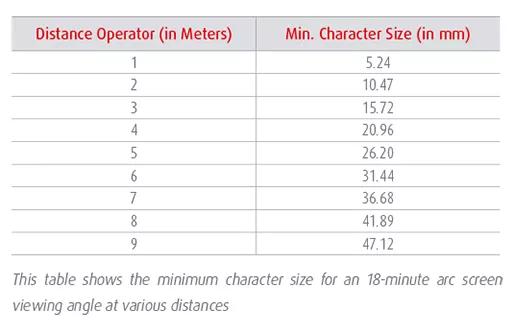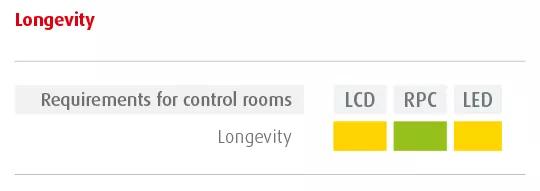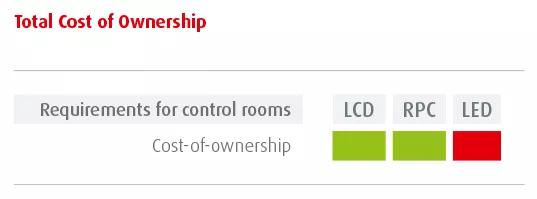Color and brightness are of vital importance in control rooms and are critical factors in comparing displays. Most video walls provide plenty of brightness and great colors at the time of installation. But the real challenge lies in maintaining a constant image quality over the entire wall, and over time.
Here, we need to make a clear distinction between Barco products and many competing brands. Many manufacturers don't consider aging effects of their products. This means that the video wall will look great upon installation, but will grow worse over time. So let's first consider the general cases, and then elaborate on Barco's solutions.
LCD technology is popular in professional video wall applications, but also in consumer electronics. However, a television set aimed at consumers has totally different requirements than a control room display. First of all, the family TV does not play 24/7 (unless the family is particularly dysfunctional). Next to that, aging is not really an issue for a stand-alone TV set. If the brightness drops 10% and the colors shift slightly, nobody will notice. If the display is part of a video wall, however, it will not match the brightness and color settings of its neighbors anymore. The result is an unbalanced wall. This can be solved by regular time-consuming (and therefore costly) maintenance visits, which also require downtime. The same goes for projection, by the way.
Direct view LED video walls suffer less from aging effects, but here you have the challenge of batch compliance. Because LED tiles are produced in batch
Things to consider: Are the colors and brightness consistent across the wall? Do you need manual intervention to keep the wall balanced in respect to color and brightness? Will the display units still be equalized (internally consistent) five years from now? Or, even more fundamentally: is it even possible to balance these discrete image generators across an entire wall?



 A display wall installed in a control room should be ergonomically friendly for the control room operators and supervisors. It is a well-known fact that the display wall should be designed for operator legibility − i.e., can he/she read the fonts?
A display wall installed in a control room should be ergonomically friendly for the control room operators and supervisors. It is a well-known fact that the display wall should be designed for operator legibility − i.e., can he/she read the fonts?
 Control rooms are built to provide situational awareness in order to facilitate fast and accurate decision-making, so uptime is of paramount importance. Failure of the video wall could lead not only to crises, but devastating financial and company image problems.
Control rooms are built to provide situational awareness in order to facilitate fast and accurate decision-making, so uptime is of paramount importance. Failure of the video wall could lead not only to crises, but devastating financial and company image problems. There is an inverse relationship between advances in video wall technology and the typical lifespan of the actual control room facility, i.e., video wall technology evolves much faster than the building housing the control room deteriorates. As a result of this dilemma, investment protection is often overlooked when evaluating the various video wall options.
There is an inverse relationship between advances in video wall technology and the typical lifespan of the actual control room facility, i.e., video wall technology evolves much faster than the building housing the control room deteriorates. As a result of this dilemma, investment protection is often overlooked when evaluating the various video wall options.